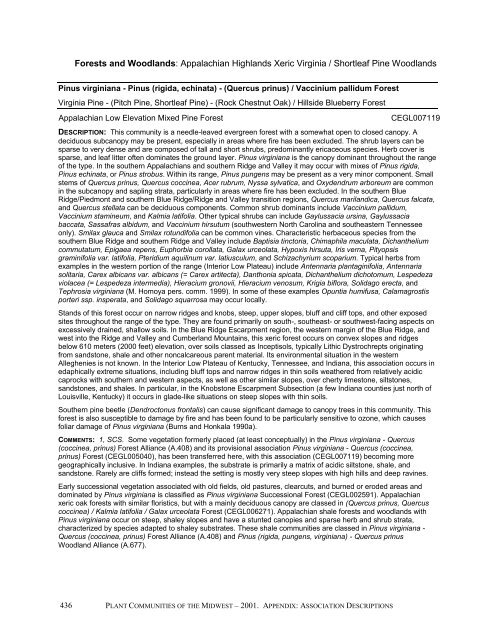Ohio subset of Plant Communities of the Midwest ... - NatureServe
Ohio subset of Plant Communities of the Midwest ... - NatureServe
Ohio subset of Plant Communities of the Midwest ... - NatureServe
Create successful ePaper yourself
Turn your PDF publications into a flip-book with our unique Google optimized e-Paper software.
Forests and Woodlands: Appalachian Highlands Xeric Virginia / Shortleaf Pine Woodlands<br />
Pinus virginiana - Pinus (rigida, echinata) - (Quercus prinus) / Vaccinium pallidum Forest<br />
Virginia Pine - (Pitch Pine, Shortleaf Pine) - (Rock Chestnut Oak) / Hillside Blueberry Forest<br />
Appalachian Low Elevation Mixed Pine Forest<br />
CEGL007119<br />
DESCRIPTION: This community is a needle-leaved evergreen forest with a somewhat open to closed canopy. A<br />
deciduous subcanopy may be present, especially in areas where fire has been excluded. The shrub layers can be<br />
sparse to very dense and are composed <strong>of</strong> tall and short shrubs, predominantly ericaceous species. Herb cover is<br />
sparse, and leaf litter <strong>of</strong>ten dominates <strong>the</strong> ground layer. Pinus virginiana is <strong>the</strong> canopy dominant throughout <strong>the</strong> range<br />
<strong>of</strong> <strong>the</strong> type. In <strong>the</strong> sou<strong>the</strong>rn Appalachians and sou<strong>the</strong>rn Ridge and Valley it may occur with mixes <strong>of</strong> Pinus rigida,<br />
Pinus echinata, or Pinus strobus. Within its range, Pinus pungens may be present as a very minor component. Small<br />
stems <strong>of</strong> Quercus prinus, Quercus coccinea, Acer rubrum, Nyssa sylvatica, and Oxydendrum arboreum are common<br />
in <strong>the</strong> subcanopy and sapling strata, particularly in areas where fire has been excluded. In <strong>the</strong> sou<strong>the</strong>rn Blue<br />
Ridge/Piedmont and sou<strong>the</strong>rn Blue Ridge/Ridge and Valley transition regions, Quercus marilandica, Quercus falcata,<br />
and Quercus stellata can be deciduous components. Common shrub dominants include Vaccinium pallidum,<br />
Vaccinium stamineum, and Kalmia latifolia. O<strong>the</strong>r typical shrubs can include Gaylussacia ursina, Gaylussacia<br />
baccata, Sassafras albidum, and Vaccinium hirsutum (southwestern North Carolina and sou<strong>the</strong>astern Tennessee<br />
only). Smilax glauca and Smilax rotundifolia can be common vines. Characteristic herbaceous species from <strong>the</strong><br />
sou<strong>the</strong>rn Blue Ridge and sou<strong>the</strong>rn Ridge and Valley include Baptisia tinctoria, Chimaphila maculata, Dichan<strong>the</strong>lium<br />
commutatum, Epigaea repens, Euphorbia corollata, Galax urceolata, Hypoxis hirsuta, Iris verna, Pityopsis<br />
graminifolia var. latifolia, Pteridium aquilinum var. latiusculum, and Schizachyrium scoparium. Typical herbs from<br />
examples in <strong>the</strong> western portion <strong>of</strong> <strong>the</strong> range (Interior Low Plateau) include Antennaria plantaginifolia, Antennaria<br />
solitaria, Carex albicans var. albicans (= Carex artitecta), Danthonia spicata, Dichan<strong>the</strong>lium dichotomum, Lespedeza<br />
violacea (= Lespedeza intermedia), Hieracium gronovii, Hieracium venosum, Krigia biflora, Solidago erecta, and<br />
Tephrosia virginiana (M. Homoya pers. comm. 1999). In some <strong>of</strong> <strong>the</strong>se examples Opuntia humifusa, Calamagrostis<br />
porteri ssp. insperata, and Solidago squarrosa may occur locally.<br />
Stands <strong>of</strong> this forest occur on narrow ridges and knobs, steep, upper slopes, bluff and cliff tops, and o<strong>the</strong>r exposed<br />
sites throughout <strong>the</strong> range <strong>of</strong> <strong>the</strong> type. They are found primarily on south-, sou<strong>the</strong>ast- or southwest-facing aspects on<br />
excessively drained, shallow soils. In <strong>the</strong> Blue Ridge Escarpment region, <strong>the</strong> western margin <strong>of</strong> <strong>the</strong> Blue Ridge, and<br />
west into <strong>the</strong> Ridge and Valley and Cumberland Mountains, this xeric forest occurs on convex slopes and ridges<br />
below 610 meters (2000 feet) elevation, over soils classed as Inceptisols, typically Lithic Dystrochrepts originating<br />
from sandstone, shale and o<strong>the</strong>r noncalcareous parent material. Its environmental situation in <strong>the</strong> western<br />
Alleghenies is not known. In <strong>the</strong> Interior Low Plateau <strong>of</strong> Kentucky, Tennessee, and Indiana, this association occurs in<br />
edaphically extreme situations, including bluff tops and narrow ridges in thin soils wea<strong>the</strong>red from relatively acidic<br />
caprocks with sou<strong>the</strong>rn and western aspects, as well as o<strong>the</strong>r similar slopes, over cherty limestone, siltstones,<br />
sandstones, and shales. In particular, in <strong>the</strong> Knobstone Escarpment Subsection (a few Indiana counties just north <strong>of</strong><br />
Louisville, Kentucky) it occurs in glade-like situations on steep slopes with thin soils.<br />
Sou<strong>the</strong>rn pine beetle (Dendroctonus frontalis) can cause significant damage to canopy trees in this community. This<br />
forest is also susceptible to damage by fire and has been found to be particularly sensitive to ozone, which causes<br />
foliar damage <strong>of</strong> Pinus virginiana (Burns and Honkala 1990a).<br />
COMMENTS: 1, SCS. Some vegetation formerly placed (at least conceptually) in <strong>the</strong> Pinus virginiana - Quercus<br />
(coccinea, prinus) Forest Alliance (A.408) and its provisional association Pinus virginiana - Quercus (coccinea,<br />
prinus) Forest (CEGL005040), has been transferred here, with this association (CEGL007119) becoming more<br />
geographically inclusive. In Indiana examples, <strong>the</strong> substrate is primarily a matrix <strong>of</strong> acidic siltstone, shale, and<br />
sandstone. Rarely are cliffs formed; instead <strong>the</strong> setting is mostly very steep slopes with high hills and deep ravines.<br />
Early successional vegetation associated with old fields, old pastures, clearcuts, and burned or eroded areas and<br />
dominated by Pinus virginiana is classified as Pinus virginiana Successional Forest (CEGL002591). Appalachian<br />
xeric oak forests with similar floristics, but with a mainly deciduous canopy are classed in (Quercus prinus, Quercus<br />
coccinea) / Kalmia latifolia / Galax urceolata Forest (CEGL006271). Appalachian shale forests and woodlands with<br />
Pinus virginiana occur on steep, shaley slopes and have a stunted canopies and sparse herb and shrub strata,<br />
characterized by species adapted to shaley substrates. These shale communities are classed in Pinus virginiana -<br />
Quercus (coccinea, prinus) Forest Alliance (A.408) and Pinus (rigida, pungens, virginiana) - Quercus prinus<br />
Woodland Alliance (A.677).<br />
PLANT COMMUNITIES OF THE MIDWEST – 2001. APPENDIX: ASSOCIATION DESCRIPTIONS<br />
436
















